As the winter winds begin to blow, I find myself craving the warmth and comfort of my favorite childhood dish – Japanese gyoza dumpling hot pot. I have vivid memories of my grandmother making this meal on snowy evenings, the savory aroma of garlic, ginger and soy filling the house as we huddled around the bubbling pot. Even now, a single bite transports me back to the cozy kitchen table, my cheeks flushed from the steaming broth as my siblings and I eagerly grabbed for the next crispy-bottomed dumpling.
I’ve tried many times over the years to recreate the magic of Grandma’s Gyoza Dumpling Hot Pot, but could never quite capture that nostalgic essence. Today, I feel a spark of hope and excitement to finally crack the code on this soul-warming comfort food from my past. As I gather the ingredients – pillowy gyoza wrappers, fragrant ground pork filling, crisp napa cabbage – tender memories flood back, filling me with the same childlike wonder and anticipation for this simple, yet special meal.
While my skills likely still pale in comparison to Grandma’s, I’m eager to keep improving my recipe until I get it “just right”. I welcome any cheerful guidance from more seasoned cooks as I continue my heartfelt quest to honor a cherished family tradition. Most of all, I look forward to gathering my loved ones on a cold winter’s night to enjoy this cozy dumpling hot pot, hoping to spread the nostalgic warmth that it brings me.
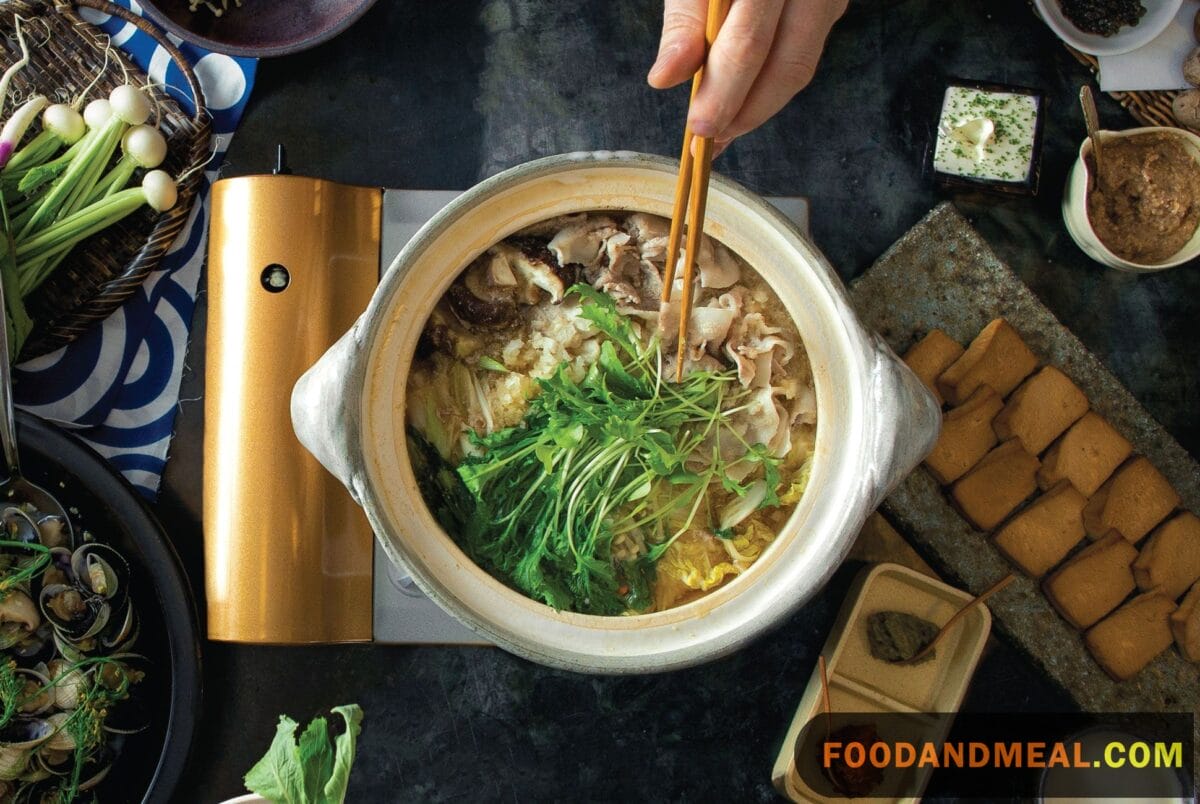
Gyoza Dumpling Hot Pot Recipe
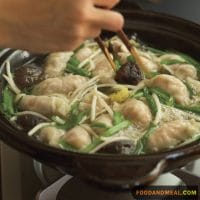
Japanese Gyoza Dumpling Hot Pot
Ingredients
For boiling in soup:
- 12 dumplings
- 5 or 6 Napa cabbage leaves
- 1 handful bean sprouts
- 2 leeks
- 4 mushrooms, shiitake
To season before you eat
Instructions
- Cut up ingredients in bite size cubes. Place in hot pot.
- Pour the soup into the pot as well.
- Boil till veggies become soft.
- Add the dumplings. You can purchase frozen or chilled Gyoza dumplings at grocery stores. Boil for 10 more minutes.
- After dumplings are heated through completely, turn heat off.
- Add sesame oil and sprinkle on some sesame seeds.
- Provide diners with individual bowls and allow them to serve themselves.
Video
Notes
Nutrition
© Food And Meal
This website provides approximate nutrition information for convenience and as a courtesy only. Nutrition data is gathered primarily from the Spoonacular Database, whenever available, or otherwise other online calculators.
Gyoza Dumpling Hot Pot: Pressure Cooker Method
Preparation is key for this delightful gyoza hot pot. Ensure all ingredients, especially the gyoza, are ready. Sauté garlic, ginger, and onions in the pressure cooker to create a flavorful base. Introduce chicken or vegetable stock, soy sauce, mirin, and sake, stirring well. Seal the pressure cooker and set it on high pressure for 10 minutes. After a quick release, add gyoza and vegetables during sauté mode, allowing them to cook for 5-7 minutes. Serve the warm concoction in bowls, garnish with green onions, and savor the deliciousness.
Cooking Tips for Gyoza Dumpling Hot Pot
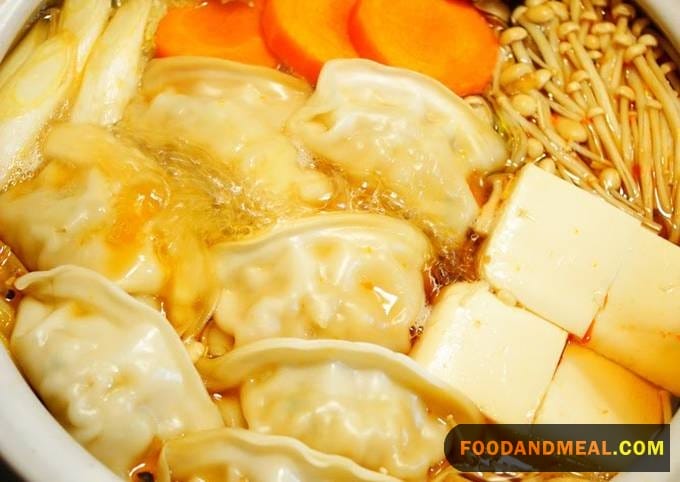
As I prepare my nostalgic Gyoza Dumpling Hot Pot, tender memories of my grandmother wash over me. I fondly recall learning at her side as a child, filled with excitement and pride at forming the perfect little dumplings.
I lovingly choose high-quality ingredients – from fragrant garlic and ginger to succulent pork and crisp napa cabbage for the filling. I beam as I carefully fold and pleat the round gyoza wrappers, just as Grandma taught me.
While sautéing, I gently brown the dumplings to achieve that signature crispy bottom without overcooking the filling. I cheerfully add the simmering broth, savoring the savory aroma filling my kitchen.
My mouth waters as I artfully arrange the cooked gyozas in the bubbling pot. I sprinkle on fresh garnishes like green onion and shredded carrot with a hopeful heart that my family will enjoy this taste of tradition.
I welcome any smiling guidance from more skilled cooks as I continue honing my technique. I aim to respectfully carry on Grandma’s legacy, not force my way as the authority on her recipe. Most of all, I eagerly anticipate gathering my loved ones to share the comforting, nostalgic warmth that this unpretentious yet special dumpling hot pot brings.
The Best Ways To Serve And Enjoy Gyoza Dumpling Hot Pot
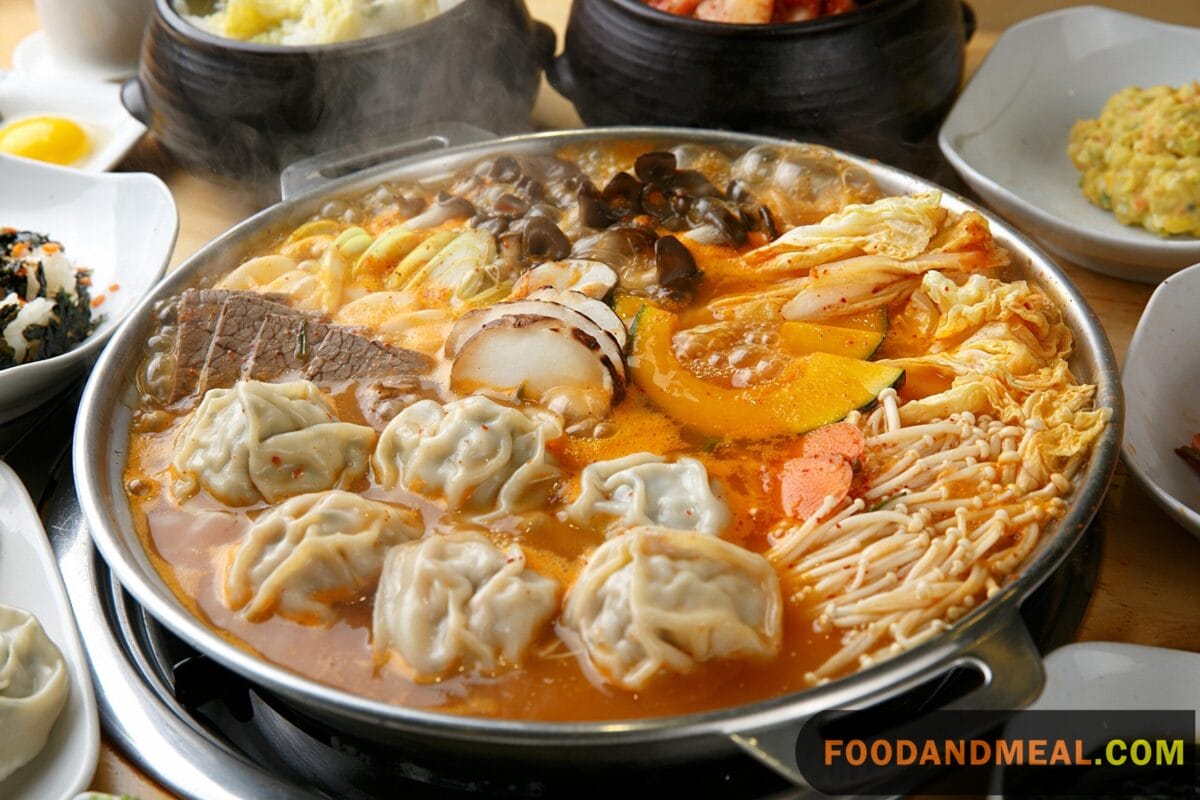
Start with the rich and flavorful Japanese Sesame Lamb Hot Pot, where the unique sesame-infused broth perfectly complements the savory notes of the gyoza. The combination of tender lamb and aromatic broth adds depth to your culinary adventure.
For a refreshing contrast to the warm and hearty hot pot, introduce the Hiyashi Chuka (Cold Ramen). This Japanese cold ramen dish offers a delightful chilliness, balancing the overall dining experience and providing a refreshing respite between flavorful bites of gyoza.
Enhance your palate with the vibrant Radicchio And Parmesan Salad, a crisp and tangy creation that adds a burst of freshness to the table. The salad’s contrasting textures and zesty flavors create a harmonious interplay with the rich and savory hot pot.
To round out the meal, consider incorporating a comforting bowl of Thick Vegetarian Creamy Soup. Its creamy goodness complements the heartiness of the gyoza, offering a delightful contrast in both taste and texture.
For those seeking a light and nutritious addition, the Vegan Japanese Spinach Salad is the perfect choice. Packed with wholesome ingredients, it introduces a healthy element to the feast, ensuring a well-rounded and satisfying dining experience.
FAQs on Gyoza Dumpling Hot Pot
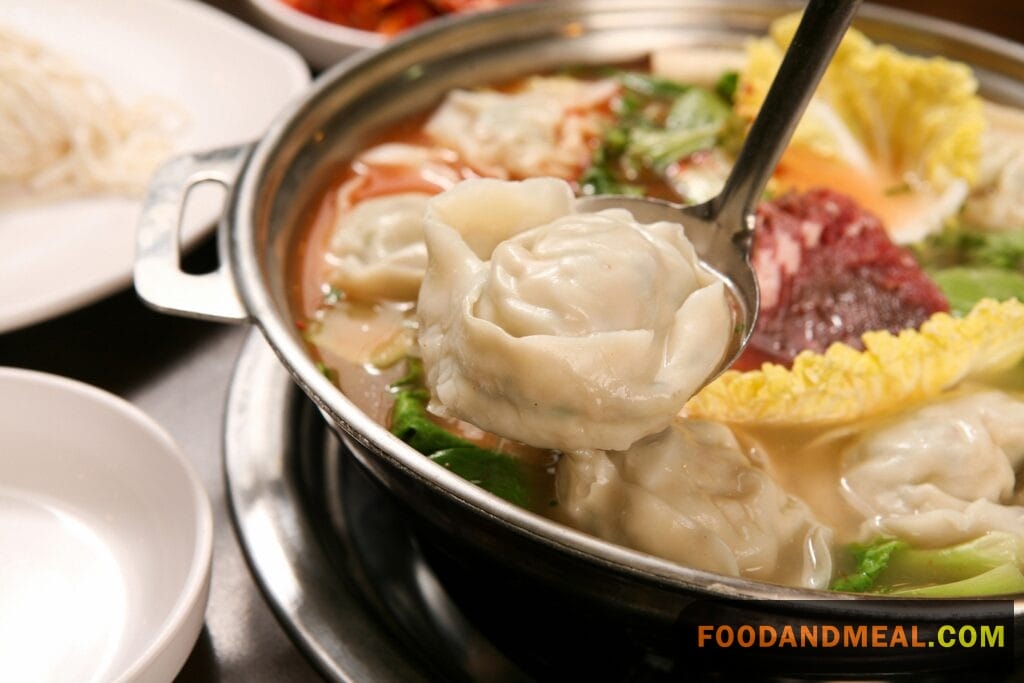
- What is a gyoza made of? Gyoza typically consists of a thin dough wrapper filled with a mixture of ground meat (commonly pork or chicken), vegetables, and seasonings. The dumplings are often pan-fried or steamed for a delicious and savory result.
- Can you put dumplings in hot pot? Absolutely! Dumplings, including gyoza, can be a fantastic addition to a hot pot. They absorb the rich flavors of the broth and add a delightful texture to the overall experience.
- Why is gyoza so good? Gyoza’s appeal lies in its harmonious blend of textures and flavors. The thin, slightly crispy wrapper encases a savory filling, creating a perfect balance. The combination of pan-frying or steaming enhances the taste, making gyoza irresistibly delicious.
- Can I use store-bought gyoza? Absolutely! If you’re short on time or simply prefer the convenience, store-bought gyoza are perfectly fine. Just ensure they’re fully thawed if frozen, and add them to the hot pot as directed.
- How spicy is this hot pot? The spiciness can be adjusted to your preference. Feel free to add more or fewer chili flakes or opt for a milder pepper. Remember, it’s your hot pot, so tailor it to your taste buds!
- What’s the difference between gyoza and regular dumplings? Gyoza is a specific type of dumpling with origins from China but popularized and modified in Japan. They’re typically more tender with a thinner wrapper compared to some other dumplings and have a distinct crescent shape.
- Can I make this vegetarian? Of course! Swap the chicken stock for vegetable broth and choose vegetable or tofu-based gyoza. You might also want to add more mushrooms or tofu for extra protein.
- How do I store the leftovers? Leftover Gyoza Dumpling Hot Pot can be stored in an airtight container in the refrigerator for up to 2-3 days. To reheat, simply warm it on the stove, ensuring the gyoza are heated through.
Conclusion
In conclusion, recreating my grandmother’s gyoza dumpling hot pot has been a delicious trip down memory lane, taking me back to cherished childhood moments around the kitchen table. While it may not yet live up to Grandma’s cooking, I’m excited to keep honing my recipe until I perfectly capture that nostalgic essence.
I hope you’ll gather some people you love this winter to enjoy this soulful, smile-inducing comfort food. Be sure to visit Food and Meal for the full recipe, as well as other cozy, craveable dishes that spread warmth on even the coldest days. Just one steaming spoonful of this dumpling-filled broth will melt your heart, along with any lingering chill. Kampai to nostalgia!
Hi! I'm Nazia of ‘Nazia Cooks’, a self-taught baker and cook residing in Chennai. Rooted in the rich South Indian culinary landscape, my palate has expanded to embrace global flavors. I revel in crafting fusion dishes, melding traditions to birth unique tastes.



